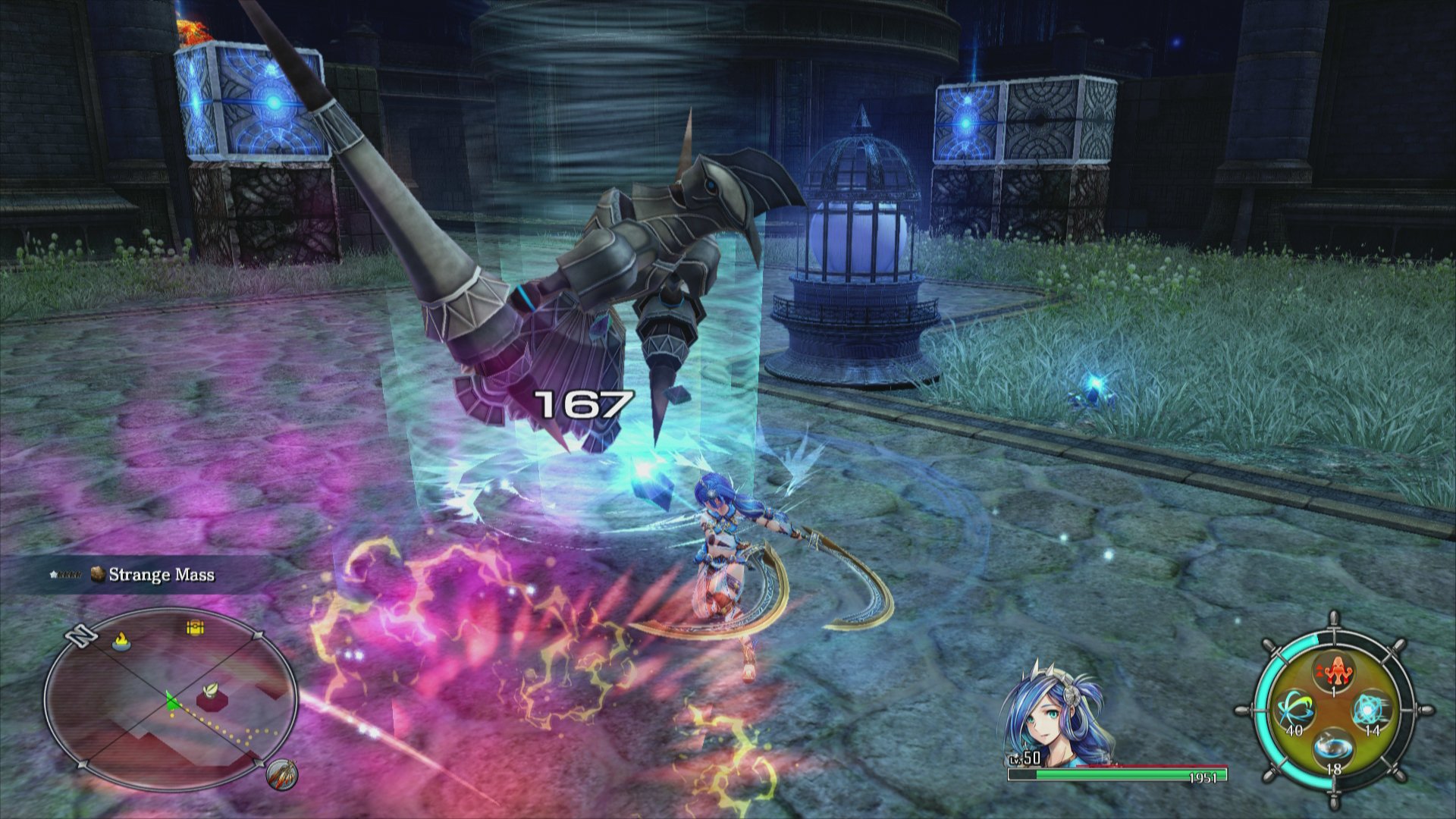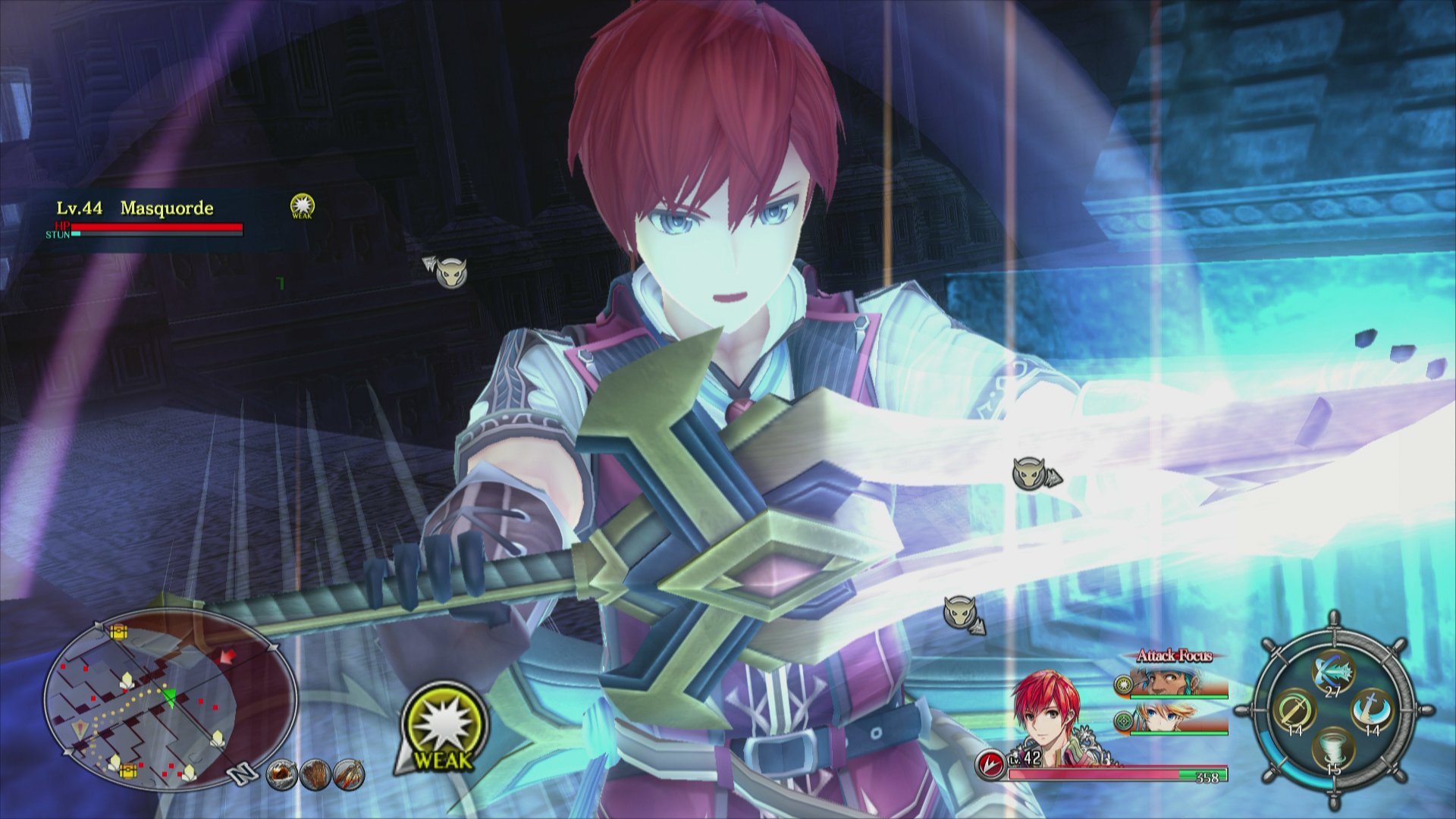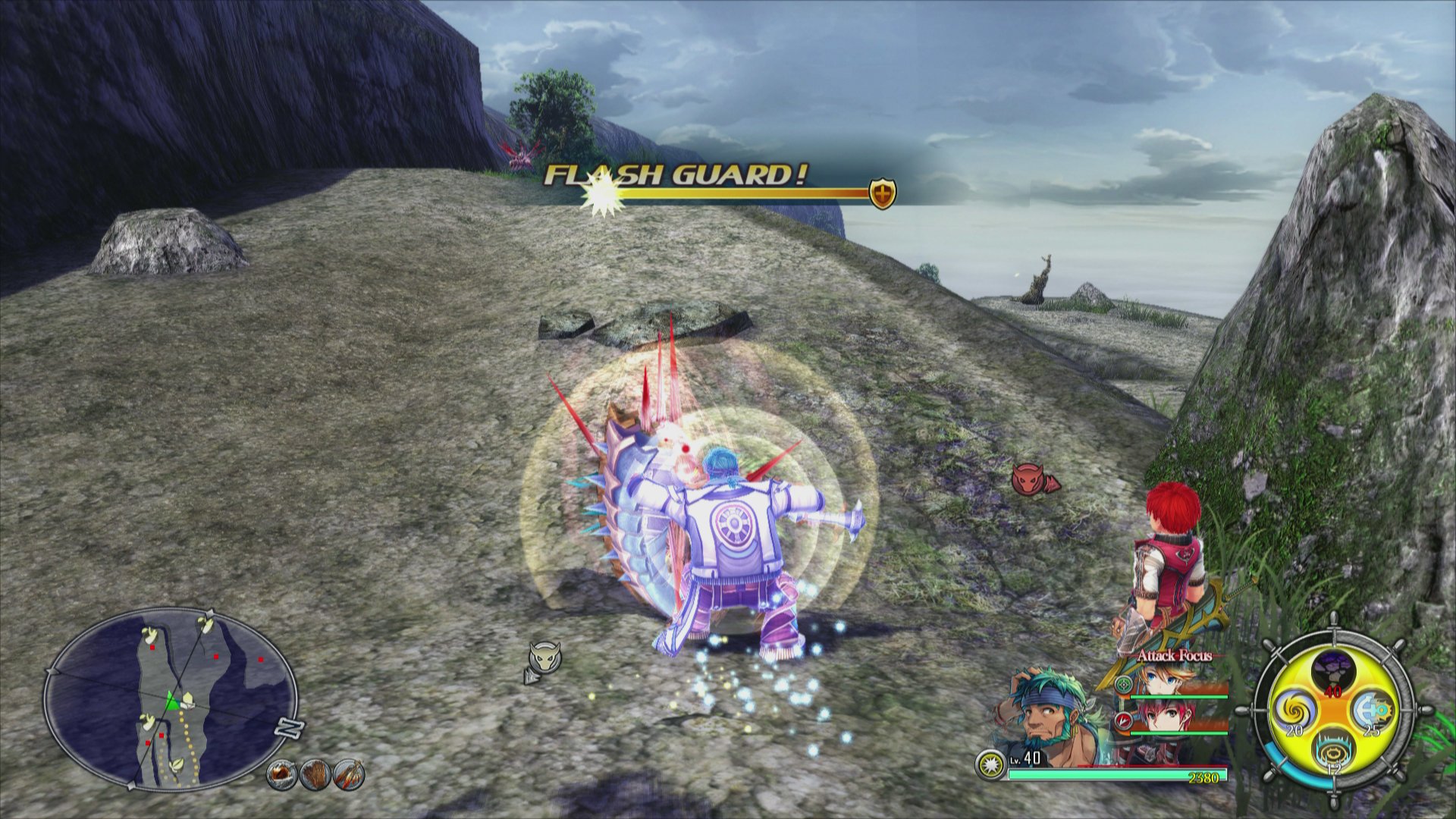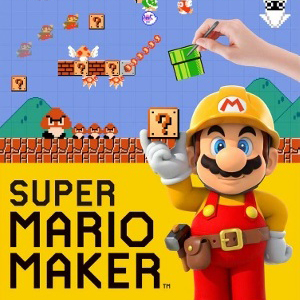
Nihon Falcom must have had some pretty big ambitions to come to the Nintendo Switch after the amazing first year the console had. With first party titles that delivered the most positive aspects of almost all genres (racing, platforming, RPGs), 2017 was a great reminder that Nintendo often doesn’t play well with 3rd party contributors due to the quality of in-house product design. But Nintendo can’t do everything, and Breath of the Wild was over a year ago, and people are finally ready for more games. So what better way to make waves than to bring the latest installment of a series that’s only slightly younger than Link? RPG fans, adventure fanatics and classic players may all rejoice, for Ys has finally come to Nintendo with the newest title, Ys VIII: Lacrimosa of DANA.
Ys is the continuing saga of the adventurer Aldo Christin, who inexplicably seems to bounce from one adventure to the next despite his best efforts to just kind of live his life. This time around, Aldo and his longtime companion, Dogi, are running security on a luxury ship that is passing by a mysterious island, the Island of Seiren. Aldo is intrigued but mostly is hoping this game will not start with a shipwreck, as many of his titles do. Aldo is out of luck, because this ship gets frigging destroyed by a Kraken of some kind and now we’ve all washed up on the aforementioned mysterious island. What happens next begins as a simple “search and rescue” mission to find survivors and, over the course of several wild dreams and bizarre discoveries, turns into a race against time with an almost literal cataclysm looming. Aldo and his companions must work together to uncover the mysteries of this island, of the ancient beasts who roam the land, and the titular Lacrimosa that is coming to rewrite history as we know it. It’s a massive, daunting storyline that will evoke some pretty strong emotions, so please be prepared.
Once you get past some initial setup, Ys VIII: Lacrimosa of DANA is a removed 3rd person 3D exploration/adventure game, with a huge island to explore and map. You actually get bonuses from the captain of the now-downed ship for every ten percent of the map that you cartograph, and you will be pleasantly surprised to find it took me about three hours to get the first ten percent reward. While exploring, you will encounter a good number of discoveries, from things as simple as treasure chests and survivors to actual sightseeing points that draw attention and awe from your party. The survivors will either go back to a makeshift village that you’ve set up and gradually expand what is available or, in some cases, join your party to go off and fight. Finding new playable characters means finding new fighting styles, new abilities and, in a lot of cases, a new way to try and balance how you’ll be heading into combat.
The way parties are handled is pretty interesting, and I think it mostly works. You can only have three active members in battle at a time, but your party will expand to have several people at one time. As a result, you need to pick and choose who you want fighting and who you want in reserve, but everyone gains experience. This means you can actually focus on who you like or want to play with instead of doing the “balance” thing where you chronically swap in characters whose style you don’t care for (looking at you, Hummel) on the off-chance that they become mandatory eventually. Everyone has different strengths against certain types, so being able to bring in someone with a better piercing weapon, a better blunt weapon or ranged attacks is pretty convenient. Naturally, they don’t let you swap characters in the middle of boss fights, so choose wisely if you think something big is coming. Hint: if you’ve just found a save crystal, you’re either about to have a very long cut scene, a boss fight, or a combination of the two.
Combat is decidedly fun and frantic, especially if you’ve been into action RPGS this year. All characters end up with a set of skills that they can bind to different buttons, allowing up to four skills at a time: these can help characters deliver multiple blows, status affects or just massive damage. But, most importantly, your heroes have the ability to dodge and block, and doing either at the right time activates a “Flash” moment where time slows down and you become invulnerable. Due to how some enemies attack, it’s entirely possible to successfully activate a flash dodge and a flash guard in the same moment, doubling your effectiveness and allowing for some serious combo action. You get this great balance where weaker enemies can be taken care of with standard button mashing, but bosses and stronger monsters ask you to develop a kind of methodology. Learn their attack patterns, combo, and retaliate. Oh, and switch to Sahad if the damage is lacking, because he’ll always be a great, brutal choice out in the field.

Lacrimosa of DANA may predate Xenoblade Chronicles 2 by a bit, but players who’ve done both will notice some similarities, for better or worse. The biggest one is the fact that new information, facets and branches of the game keep rolling out even several hours into the main storyline. As the village of rescued passengers expands, new shops and spots will open up, which will expand even more questing possibilities and even newer ideas of how to spend your time. There are raid battles to protect the village that are mostly optional (though you do want to do your best to participate to help everyone). There’s the quest for jewels and stones to trade for better weapons and rare trinkets. You never quite get over seeing the pop-up informational screens, because, even when you’ve gotten your total bearings on the game, here comes another “adventure” item that needs to be explained so that you can explore another nook of the island you missed previously.
However, the way that Ys VIII treats the roll out of information is a double-edged sword in terms of information saturation. On the one hand, the technical explanations are brief, voiceless and purely to let you know what you can do/must do now. In comparison to the incredibly long detailed bits that Xenoblade gave, or the almost wordless, “good luck figuring it out” methodology of Breath of the Wild, Lacrimosa of DANA has a real sweet spot in terms of educating without boring or under detailing. I would play for a couple of hours and then suddenly learn something new, read it over quickly and then make it work. I didn’t need hours of practice to figure out how to fish, it just simply worked. There’s no Professor Oak to make you sit through hours of wild grass hunting, just you and your party going at the world together. If you really want to, everything is well documented at the push of a button for reference and referral, but most RPG/adventure game veterans will be able to memorize the facts pretty quickly. In this way, the game is pleasant, almost effortless, in terms of picking up and retaining knowledge.
But, in terms of storytelling (aka one of the most important RPG factors), things roll out at an almost painfully slow rate. Sure, right off the bat, we meet Aldo, we see him labeled as an adventurer, and then we get shipwrecked. Alright, perfect, no problem. But then we spend many, many hours just finding survivors from the ship, corralling them, and figuring out what happens next. This wouldn’t be a problem if the whole DANA thing was a secret, but it’s right there in the title of the game. Our introduction to who and what DANA is so incredibly gradual that players would forget about her if Aldo didn’t have dreams once in a while to remind us. By the time you finally find out what DANA is and how that ties into how you’ve gotten there, you’re in double digits in terms of gameplay. If I watched ten hours of a television show just to find out why Kiefer Sutherland needs to run around and yell at people, I would have turned it off. For people who are just here for the storyline, it’s a goddamn nightmare to unpack everything.
Thankfully, Ys VIII: Lacrimosa of DANA is far from a straightforward, meandering tale. You can easily, easily spend multiple happy hours doing everything BUT advancing the plot. There are sidequests given to you by castaways, hidden treasure chests, notes and clues from previous island inhabitants and just tons of things to improve on from top to bottom. Grinding up your character is far from a chore because your highly aggressive party members will attack almost everything when given the chance, and everyone benefits from the EXP gained there. Multiple times, I would instigate against an enemy and then purposely put myself in a place that was still visible but mostly out of reach for the mob, and then my AI companions would go to town while I reaped the benefits. This was all so I could just build some damn boats that Dogi had been hounding me for since the beginning of time. I’M WORKING ON IT DOGI, THERE ARE MORE IMPORTANT MATTERS RIGHT NOW.
I will warn that, as anime as every game has been that I’ve mentioned in this article, Ys is far and away more “anime” than any of the others. Firstly, there is only English voice work available for players. I don’t know if that’s a make or break for some people, but I do enjoy Japanese voice work when I have the option. But the tropes for a lot of the characters are so heavyhanded it’s crazy. We’ve got a big dude who’s flatulent and brash but has a heart of gold, a tsundere, high-class woman who slowly opens up about herself, a hyper-energetic child who is a great fighter and wise beyond her years, and a mysterious hitman-esque character who is keeping secrets but you’re drawn to his cold-as-ice demeanor. There’s actually sweat drops, furious blushing and hanging mid-air ellipses in conversation, and that’s before you get to see any of the actual anime cutscenes (which are beautifully done, by the way). I just think a heads up for people who are less into anime than others is in order to prevent annoyance and being blindsided by things.

As for the game’s performance…alright, this is a divisive topic. Anyone who’s been aware of Lacrimosa of DANA knows that the game was great launching on the PS4 and a technical nightmare on the Steam release (though most of those bugs have been stamped out at the time of this writing). The Switch version falls somewhere in between, and I’m leaning more towards the PS4 side of things. On the one hand, the game runs incredibly smooth: load times were incredible, and I usually didn’t have enough time to read the text that popped up on the load screen (thankfully, a lot of it recycles, so I could read it later on). For a game with a 14GB footprint, it carries its weight well, keeping things smooth and fresh with only minor slowdown at the climax of an ultimate skill move or when a boss died. Then again, those slowdowns could have been intentional to make the game appear more dramatic, but I couldn’t be certain.
On the other hand, there were moments of sheer ugliness that honestly caught me off guard. Given that you spend a vast amount of time playing the game on a tropical island, you would imagine that water would be a major facet in background, foreground and most other ground, and that Nihon Falcom would take extra care in making it look good as a result. Half of that is accurate with the Nintendo Switch port. Water is everywhere: you’re surrounded by it, you fish in it, you wade in it, you can drown in it. And it often looks terrible when you’re in it: your character’s outline gets hazy and pixellated around the edges, like they’re dissolving into the water. There are times when the camera swings at the wrong angle and, suddenly, my characters are wailing away on a beast that cannot be seen and it looks like I’m just shadowboxing. Other times the camera will position itself so that I can’t even see my characters, just watch my life meter drop because I’m pinned into a corner and can’t do anything but frantically dodge roll until I get my bearings. These moments really sullied things, and made me less than enthusiastic about continuing to play.
But I did. I continued because I was positively enthralled by Ys VIII – Lacrimosa of DANA. And not just because the story is banging (which it absolutely is). Not just because I was totally engrossed in the sprawling, unbelievably captivating world of Ys that has countries spelled just slightly differently than Earth (seriously, Afroca and Romun empires are a thing). It’s because the music is just SO amazingly good. You feel like things are going to be a chore and then you get out into the overworld and the drums and guitar riffs kick in, and you are PUMPED. I’ve been a huge promoter of Final Fantasy music because Uematsu knows exactly how to paint a fantasy soundtrack that’s epic and engrossing, but I’ve always had a soft spot for Mystic Quest because of the driving guitar. Ys has all that and more, with music that can only be described as a perfect fit for the adventure that you’re on. This isn’t some turn-based combat system that gives you the luxury of a removed feeling, this is an action RPG and you are in it, blood to blade, and the music reminds you of this every step of the way. Holy Christ, this is one of the few games that I need, NEED to have the speakers up or my headphones in to play, because separating the music is like ripping a piece of the game’s essence away. You can do that with other titles, and I’ve had to. If I can’t play Lacrimosa of DANA without the music, I straight up can’t play it.
This review may dwarf my other writeups, and I feel that it comes with good reason. Ys VIII – Lacrimosa of DANA is a massive undertaking, and is a legendary installment in a legendary game series. You can put sixty hours into this game, easily, and not be done with it. Though it may seem small compared to the neverending nature of Xenoblade Chronicles 2 (especially with the DLC) or Breath of the Wild (again, DLC), this is, nevertheless, an amazing undertaking for Nintendo Switch players. There are shortcomings that I mentioned above, and maybe the DLC here (available instantly) is a bit superficial (costumes, mostly bathing suits), but that doesn’t detract from what the game does well. Great music. A huge map. Solid load times. Brutal combat. And a story that is the definition of a slow burn in an RPG. It might take a while to catch, but, once Lacrimosa of DANA starts burning, it will take all your time and attention and consume until there’s nothing left. And you’ll say thank you.

REVIEW CODE: A complimentary Nintendo Switch code was provided to Bonus Stage for this review. Please send all review code enquiries to press@4gn.co.uk.
Subscribe to our mailing list
Get the latest game reviews, news, features, and more straight to your inbox
Thank you for subscribing to Bonus Stage.
Something went wrong.
-
Gameplay - /10
0/10
-
Graphics - /10
0/10
-
Sound - /10
0/10
-
Replay Value - /10
0/10





